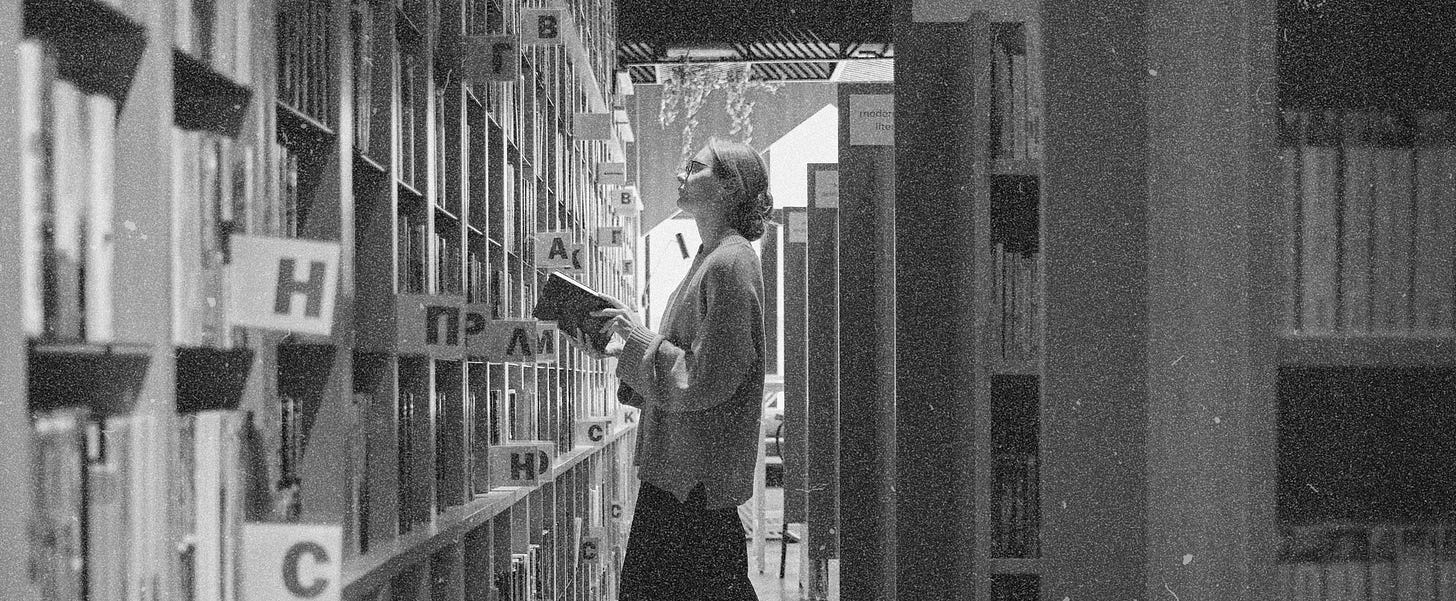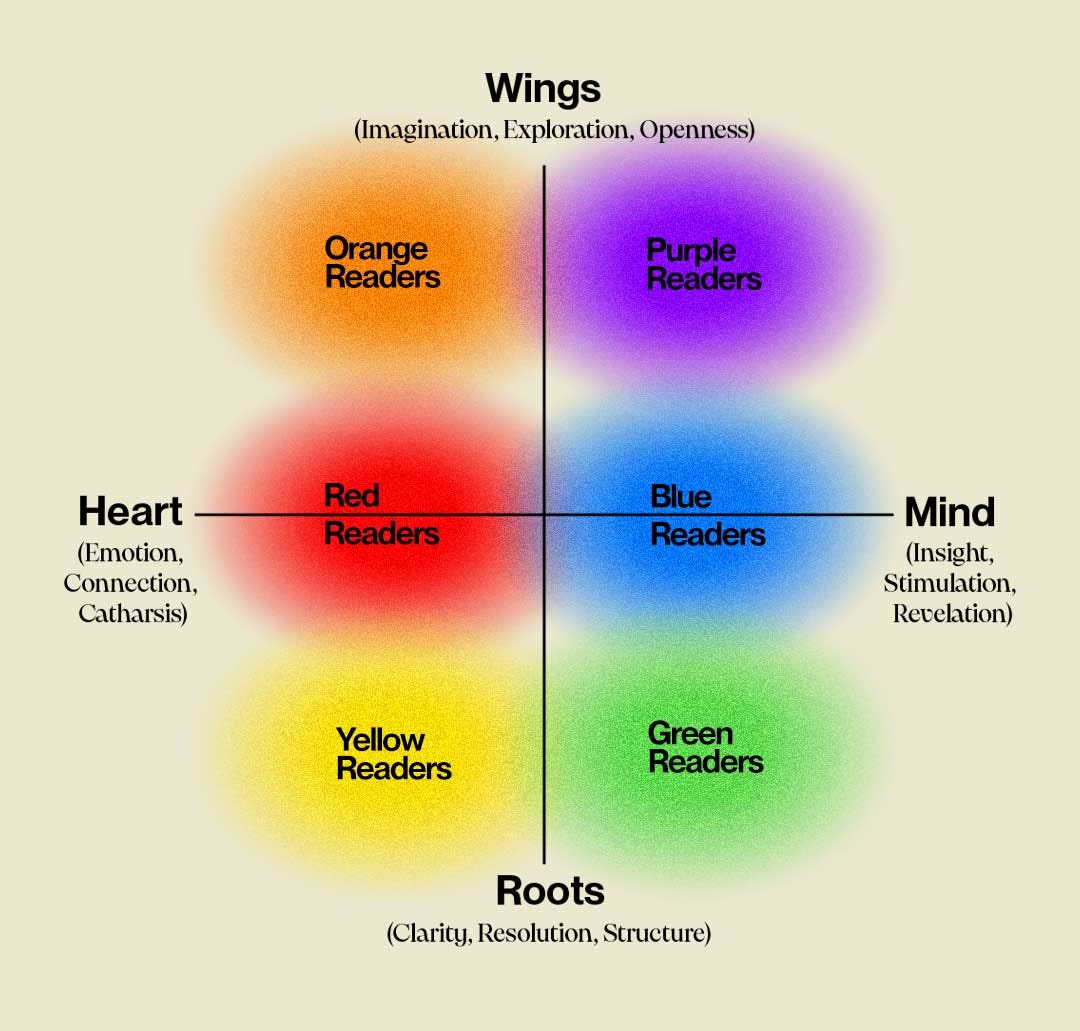How Each Color Should Use the Library
Your personal guide to how each color type can get the most out of their library card

It took having a kid to realize how amazing the library was.
I know. I'm embarrassingly late to this discovery. Many of you have been library regulars since childhood. Not me. I was the kid who only showed up for the Scholastic book fair to buy posters and those long bendy erasers. As an adult, I walked past my neighborhood library for years without a second thought. Two blocks from my house, and it might as well have been invisible.
Why would I need a library card? I had Amazon. I had Audible. I didn't mind paying for books. They felt like a good investment, and "free books" alone wasn't enough to lure me in.
Then came my son Lewis, and with him, the universal parental desperation of rainy afternoons with a stir-crazy toddler. We needed somewhere to go. Anywhere. The library was open and dry.
I got us library cards and walked Lewis to the children's section. Within minutes, I was asking my wife to watch him so I could browse the other shelves. By the time we left, I was more excited about my stack than he was about his.
I discovered something that day: Free books are nice, but they're not the real gift. The library offers something far more valuable—an escape from the entire system that's making us worse readers.
Let me explain.
The real value of the library — beyond free books.
Every time we open Amazon or walk into a bookstore, invisible forces guide our choices. The algorithm knows what we bought last time. The bestseller table shows us what everyone else is reading. BookTok convinces us that you need that specific edition with the sprayed edges (which I loathe by the way, if you like them i’m sorry it’s not personal). Before you've even started browsing, your choices have been narrowed to what you're supposed to want.
Libraries break this entire machine. When you walk in, nobody's tracking your browsing history. Nobody's optimizing your choices. Nobody's trying to sell you anything.
And all those must-read books everyone's talking about? They're gone. Checked out. Waitlisted for months.
Fourth Wing? 47 holds ahead of you. The latest Psychological Thriller? Good luck. That viral memoir everyone's crying about on TikTok? Someone beat you to it.
At first, this seems like a problem, but I have found that it’s actually a HUGE opportunity.
When the obvious choices vanish, something incredible happens: you have to browse. Really browse. Not scroll through curated recommendations or "customers also bought" suggestions. You have to walk the aisles and pull books off shelves and make decisions based on nothing but your own curiosity.
You have (or, get) to think for yourself.
…but free books aren’t bad either
Libraries give us the chance to screw up. That intimidating classic you've always meant to read? Check it out. Hate it? Return it. That weird book about the history of concrete workers after the New Deal ? Take it home. Turns out it's boring? No guilt, no wasted money, just a lesson learned.
This zero-risk environment changes how you can approach reading. You can experiment. You can challenge yourself. You can pick up books you'd never spend $30 on but might spend an evening with. You can quit books without feeling like you failed.
Most importantly, you can read widely without going broke. Want to explore philosophy? The library has hundreds of titles waiting. Curious about poetry but not sure where to start? Take home five collections and see what speaks to you.
The library transforms reading from a consumer choice into an intellectual adventure.
The Three-Book Strategy: How to “shop” the library without decision paralysis.
Here's where most people get overwhelmed. They either grab one safe book and leave, or they check out eight books in a fit of ambition and return them all unread. Both approaches waste what the library offers.
Instead, use the Three-Book Strategy. Every library visit, you're building a balanced reading portfolio. Here's exactly how to do it:
Book One: The Comfort Read (Read YOUR Color)
Start by reading in your color. This is the book that feeds your natural reading instincts. Pick it up, read the back cover, check the first page, look at the cover art. If it pulls you in, it's yours.
Don't know your reading color? Pay attention to what consistently draws you:
Red Readers: Look for high stakes, intensity, moral dilemmas. Back covers that promise betrayal, survival, or psychological complexity. First pages that start with tension.
Yellow Readers: Seek emotional journeys, relationship dramas, books promising tears or transformation. Back covers mentioning love, loss, family secrets. First pages with immediate emotional hooks.
Blue Readers: Find quiet character studies, philosophical questions, lyrical prose. Back covers focusing on inner life or existential themes. First pages with beautiful, contemplative language.
Green Readers: Hunt for true stories, practical wisdom, historical accounts. Back covers promising insight or lessons learned. First pages that establish credibility and clarity.
Purple Readers: Search for experimental structures, unreliable narrators, genre-bending concepts. Back covers that sound weird or rule-breaking. First pages that disorient or surprise.
Orange Readers: Discover immersive worlds, epic scopes, adventure. Back covers describing new civilizations or grand quests. First pages that transport you immediately.
Book Two: The Bridge (Switch Your Format)
Stay in your color, but flip the format. If you usually read Yellow fiction (contemporary romance, family dramas), try Yellow nonfiction. If you're a Green nonfiction reader, explore Green fiction.
Here's how to identify books in your color across formats:
Red (Fiction → Nonfiction): From thrillers to true crime, war histories, investigative journalism about scandals, biographies of complex figures
Red (Nonfiction → Fiction): From true crime to psychological thrillers, noir, morally complex literary fictionYellow (Fiction → Nonfiction): From emotional fiction to memoirs about love/loss, books on relationships, personal essays about family
Yellow (Nonfiction → Fiction): From memoirs to contemporary fiction, family sagas, character-driven stories about connectionBlue (Fiction → Nonfiction): From literary fiction to philosophy, spiritual memoirs, essays on meaning, psychology of consciousness
Blue (Nonfiction → Fiction): From philosophy to quiet literary fiction, existential novels, contemplative storiesGreen (Fiction → Nonfiction): From historical fiction to actual history, biographies, how-to guides, books explaining how things work
Green (Nonfiction → Fiction): From nonfiction to historical fiction, biographical novels, stories based on real eventsPurple (Fiction → Nonfiction): From experimental fiction to cultural criticism, theory, manifestos, books about art/creativity
Purple (Nonfiction → Fiction): From theory to postmodern fiction, magical realism, genre-defying novelsOrange (Fiction → Nonfiction): From fantasy/sci-fi to travel writing, nature books, space exploration, anthropology
Orange (Nonfiction → Fiction): From travel writing to epic fantasy, science fiction, adventure stories
Book Three: The Adventure (Adjacent Color)
Look at where your color sits on the spectrum. Pick a book from a neighboring color. One that “touches” yours. This will push you into new territory without overwhelming you.
***Note that blue and red border all colors technically. Admittedly this is a bug I’m working out. I only included two “neighbors” below!
Red Readers → Try Orange (add imagination to your intensity) or Yellow (add emotional depth to your drama)
Orange: Look for dark fantasy, dystopian worlds, survival in alien settings
Yellow: Look for psychological dramas with romantic elements, family thrillers
Yellow Readers → Try Red (add intensity to your emotion) or Green (add grounding to your feelings)
Red: Look for romantic suspense, emotional thrillers, love stories with dark twists
Green: Look for memoirs by people you admire, practical books about relationships
Blue Readers → Try Green (add practicality to your depth) or Purple (add experimentation to your introspection)
Green: Look for biographies of thinkers, history of ideas, practical philosophy
Purple: Look for avant-garde fiction, stream-of-consciousness, philosophical sci-fi
Green Readers → Try Blue (add depth to your practicality) or Yellow (add emotion to your facts)
Blue: Look for books on meaning-making, wisdom traditions, reflective histories
Yellow: Look for memoirs that made people cry, histories told through personal stories
Purple Readers → Try Blue (add soul to your rebellion) or Orange (add adventure to your experiments)
Blue: Look for philosophical fiction, books questioning reality, meditative experiments
Orange: Look for weird fiction, surreal adventures, genre-mixing epics
Orange Readers → Try Purple (add weirdness to your worlds) or Red (add intensity to your adventures)
Purple: Look for bizarro fiction, experimental sci-fi, reality-bending fantasies
Red: Look for dark fantasy, high-stakes adventures, morally complex quests
Your Next Steps
This week, visit your library. Know your color. Build your three-book portfolio. Spend 30-45 minutes.
Leave with exactly three books.
Then watch what happens. Notice which books surprise you. Pay attention to what you actually finish versus what you thought you wanted. The library is about discovering what you actually like to read when nobody's watching, tracking, or selling. It's about choosing books based on your own wiring instead of someone else's algorithm.
And if you’re rolling your eyes because I’m so late to the Library game — I forgive you, please forgive me.





Every so often my local librarians put up a display of books of the same color, not reader preference color, but based on the primary color of the book cover, book jacket, or book cover illustration. It's visually stunning and totally random, so browsing the choices is the most anti-algorithm process ever. Even kids' books are mixed in. Librarians are subversive.
At a bookstore on vacation, I very nearly bought the new kitten-squisher Twain biography by Ron Chernow. But, I know I’m a green reader, and I know that Chernow biography is more aspirational than practical, so I put it down, saving it for another time possibly, and picked up the new Matthew Pearl nonfiction, Save Our Souls, which is giving David Grann’s “The Wager” vibes and which I know I will devour. You are saving me money Mr. Reese!